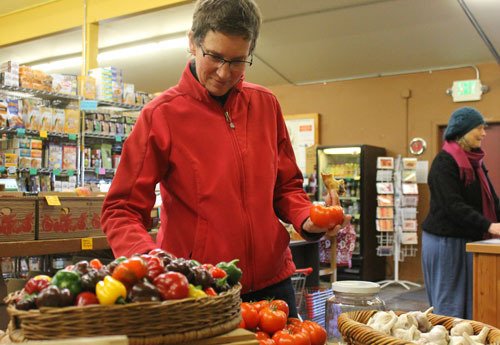From a small retrofit storage unit, to the 1,650 square foot building it occupies today–size matters at the San Juan Island Food Co-op.
At the Food Co-op’s location on 775 Mullis Street, which opened in 2011, 750 members come to shop the shelves stocked full of organic, low-preservative, minimally packaged, local, regional groceries. Customers can be sure that all items offered meet at least three of those characteristics.
Although you can rely on dry goods and other staples to be at the Co-op year round, the produce section changes in cycle with the seasons. This time of year you’ll find boxes of ripe apples, baskets filled with garlic, and squash lining the walls.
“What we try to provide are the best possible choices in food and products,” said Manager Anna Coffelt, who came onboard when the Co-op moved to its bigger location. “We do our research on every brand we bring in.”
The co-op started out seven years ago with only 50 members and, before it moved, membership had grown to about 300. Coffelt said the decision to move was necessary because the smaller space was no longer large enough to accommodate the expanding community interest.
Creating more space
Nearly four years since the doors opened on Mullis Street and it’s time to expand again. A volunteer effort this summer transformed an unused back room of the building, that once functioned as a metal shop, into a space to store food, sort deliveries, and host workshops and cooking classes.
Coffelt said the space will eventually be used to stock and sell more bulk foods, local produce, and meat supplies. The Co-op is also planning to add bulk spices and prepared foods to the shelves.
With San Juan Island declared GMO free, and many people becoming more conscious of the effects of what they eat on the environment and their health–the Food Co-op is a gathering place of like minds in the community.
“We certainly don’t have the selection as the larger grocery stores,” Coffelt said. “But people shopping with guidelines in mind, if that’s important to them, know they can shop here.”
Islander and Co-op customer Theo Pratt keeps specific guidelines in mind when he’s shopping. As a sufferer of certain food allergies, the Co-op is a great place for him to purchase food that won’t jeopardize his health, while participating in the growing conscious eating collective.
“It has a number of groceries I can’t get anywhere else. There’s a great organic section,” Pratt said. “Plus, it’s a local, community thing.”

SJI Food Co-op isn’t run in a cooperative sense, where members are paid dividends at the end of each fiscal year. Yearly membership fees help pay for the store’s infrastructure, like shelving, bulk food containers, freezers and coolers. To be a member also means a better discount, as non-members are charged five percent more.
Operating as a company rather than a standard cooperative, the Food Co-op is remarkably debt-free.
“The co-op has grown organically, when we have the money,” Coffelt said. “I think people on San Juan, more than other places, appreciate that debt-free mindset.”
An example of that commitment to debt freedom happened this summer, when a catastrophe hit the Co-op’s freezer, and members donated a total of $8,000 for new freezer equipment.
The Co-op keeps its costs down and prices low by purchasing second hand equipment. However, with more and more products coming through the doors, the need for reliable appliances has heightened, Coffelt said.
Through modern-day “hunting and gathering,” employees and volunteersleave the island once a week to search for small, entrepreneurial farms and businesses. From free-range meat, to hand crafted beauty products, to condiments–the co-op has been adding local and regional vendors at an average rate of two per month.
On average, according to Coffelt, 20 percent of groceries offered at natural food stores throughout the nation are local or regional. At San Juan’s food co-op, its localized products hover at 50 percent, and are bound to increase as more vendors are added.
Coffelt credits volunteer Eleanor Hartmann for the growing number of local and regional offerings. Since Hartmann’s involvement with the Co-op when its doors first opened, she’s been adamant about consistently looking for more suppliers.
With the monthly increase in vendors, turning the new space into a functioning part of the store, and the need for dependable appliances–the Co-op faces a unique challenge, remaining debt free.
A combination of fundraisers and grant requests are in the works to prepare for the expansion.


